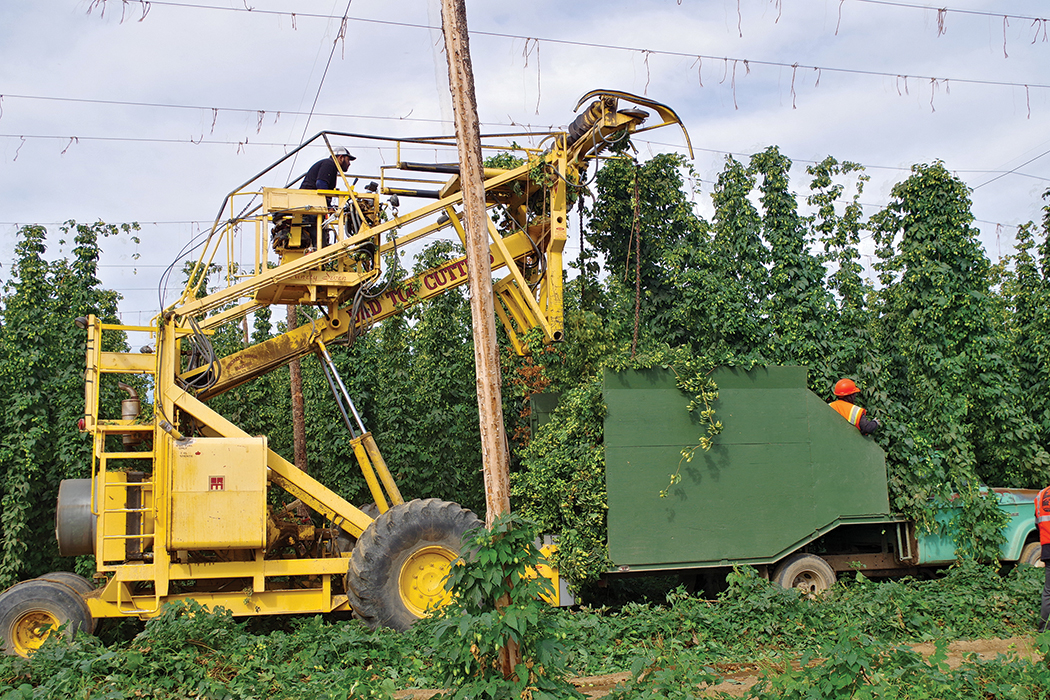
Home » Low yields don’t damper hop growers’ optimism
Low yields don’t damper hop growers’ optimism

June 14, 2023
Last year has been described as a challenging one for the hop industry, coming off a previous record crop, unseasonably cold and wet spring and increased costs for production.
But the industry is hopeful 2023 brings a better hop crop.
“We’re about one week behind in heat units with another cool spring, but that’s something we can gain back and we’re still optimistic we can make that time up in the future,” said Maggie Elliot, science and communications director for Hop Growers of America, in early May.
The 2022 U.S. hop harvest topped just over 100 million pounds, valued at $617 million. This is about 12% lower than the previous year’s harvest.
Washington keeps a strong hold on the hop market for both the Pacific Northwest and the nation, producing about 70% of what’s grown in the region. As an industry, hop growers provide 40% of the worldwide hop supply, with the lion’s share grown in the Yakima Valley.
The amount of hops planted remains fairly stable year over year, with a slight decline in acreage, amounting to about 50,000 acres in the Pacific Northwest, with nearly 43,000 acres planted in Washington. Less than 1,400 acres of farmland are dedicated to hops elsewhere in the nation.
The most popular hops for beer are typically Alpha or Aroma, providing bitterness with Alpha, or, as the name implies, aroma with the latter.
Aroma varieties have exploded in Washington in recent years with Citra remaining the top crop once again, and Cascade, CTZ or Mosaic rotating around on popularity.
Citra hops add citrus notes in the brewing process, with flavors like peach, passion fruit, lemon and melon.
Diversifying
In 2022, there were more acres planted of Citra, an aromatic hop, than all varieties of Alpha combined. In the Northwest, more than 80% of hops grown last summer included Aroma or dual-purpose varieties, with Alpha accounting for the remainder. A decade ago it was split about 50-50, but a shift could be forthcoming.
“Germany had a historic drought, and its yields were cut nearly in half,” Elliot said. “Since Germany grows a lot of Alpha, I think a lot of the large brewing companies started to realize they had concentrated much of their supply chain in the Alpha hops in Germany, and the country only has about 20% of fields irrigated.”
With much of the crop at the mercy of weather and no infrastructure in place to address a drought, growers may see a change in varietal demand.
“I think there was a bit of a realization that the hop market was at risk,” Elliot said. “Generally speaking, the U.S. will likely start to grow more Alpha to offset that concentration in Germany. Some growers are pulling out Aroma this year and putting in Alpha acres.”
Rising costs
As with plenty of other things in America, costs to growers have substantially increased over the last year. The most recent analysis by Washington State University estimated it costs $13,588 per acre to produce mature, standard trellis hops under drip irrigation. But that total was updated prior to rises in labor, supply, fuel and other necessary costs. The U.S. Bureau of Labor Statistics recently estimated the cost of hops production at $15,368 per acre.

“Labor is one of the foremost challenges our industry faces,” Elliot said. “I wouldn’t say it negatively impacted yields at this point, but we are entering a time where it will be increasingly difficult for our growers to meet the needs of their operation when harvest comes with the new overtime standards. Hops are a very labor-intensive crop with every single string done by hand.” This work occurs in the spring and harvest often begins in late August and continues through October.
“Inflation and overtime pressures have caused agricultural labor costs to increase here in Washington,” said Scott Dilley, public affairs director for Wafla (Washington Farm Labor Association). “These costs, along with many other increased input costs, have made it harder for farmers to be profitable.”
Hops are considered an expensive crop to grow due to initial startup costs.
Hop Growers of America says, “growers have faced substantial increases, driven by expansion of harvesting and production capacity to handle a doubling of acreage over the past 10 years, updating equipment, increased labor costs and inflation. Administrative and operating costs associated with food safety, best practices compliance and other customer requirements have also increased.”
Labor shortages
Hop Growers of America said about half the labor in its industry relies on the federal H-2A domestic worker program and the remainder is made up of migrant or local workers.
“The labor shortage in agriculture persists, and farmers have had to turn to the H-2A program to find enough workers,” Dilley said.
Wafla said in 2011 more than 5,000 H-2A jobs were certified by the Employment Security Department. In 2022, that number had increased to more than 33,000.
Before jobs are certified for the H-2A guest worker program, federal laws require growers to advertise those positions to workers already here in the U.S. In 2022, ESD’s WorkSource referred only 11 workers for these 33,000 jobs.
“These figures demonstrate the extent of the labor shortage in agriculture and a dramatic increase in usage of the H-2A program,” Dilley said.
“We hope to create more modernization in our technologies to be able to reduce the workforce, whether that be different types of weeding systems or novel tools or technologies that we introduce to cut down on the dependability on the human workforce,” Elliot said.
Weathering the weather
Described as an “atypical” spring with measurable snow as late as April, record cold and wet months as part of a La Niña climate pattern were blamed for critically delaying development of the 2022 hop crop. Growers could only sit by and watch, hoping for hops to mature.
“Hops are a plant that needs daylight to really thrive,” Elliot said. “They can grow up to 12 inches in a single day when they’re reaching for the top wire. When they do not get sunlight at that particular point in time, it can really hinder their growth and delay maturity.”
Elliot illustrated how the crop acts similarly to grapevines and suspends ripening when the temperature rises above 95 degrees.
“It turns from photosynthesis to photorespiration. It just kind of hangs on and goes into survival mode. Every minute of the day it was over 95 degrees, the hop cones weren’t ripening, and our harvest was delayed about seven to 14 days.”
This contributed to overall production being off about 15% in Washington state.
Growers typically see about 1,889 pounds per acre of hops grown, but 2022 brought outputs averaging 1,694 pounds. Yields were the lowest in Washington across the Pacific Northwest and down significantly from a decade ago when the average was 2,025 pounds per acre.
Top export markets
About half the crop is exported each year, sent mainly to Belgium-Luxembourg, home of AB InBev, the world’s largest brewing group, as well as Germany and the United Kingdom.
“It’s such a unique industry because it is such a large proportion of the world market,” Elliot said.
Craft breweries saw big impacts from the Covid-19 pandemic, but the industry rebounded by 2022, making up about a quarter of retail sales.
Despite dominating the world market, American hops are still a relatively small commodity, comparably, which results in limited efforts to innovate new efficiencies.
“The industry has investigated opportunities to build a ‘twiner’ technology, but it is very difficult, and we’re such a small industry that technology has been rather elusive,” Elliot said.
Agriculture + Viticulture
KEYWORDS june 2023





